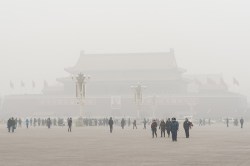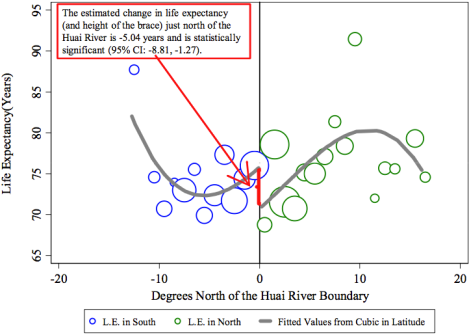
ShutterstockNow that’s some bad air quality.
Residents of northern China got free coal from the government during winters from 1950 to 1980, but it turns out that the coal actually came at a heavy price: shorter lifespans.
The Chinese government’s Huai River policy provided coal free of charge to everybody living north of Huai River, which cleaves China in two. As residents of northern China, the colder part of the country, huddled around fuel burners inside their homes, the air outside was growing black with particular matter. Breathing that air robbed northern residents of an average of 5.5 years of their lives compared with their southern compatriots.
That’s the stark finding of a new comparison of historical pollution levels and mortality data north and south of the Huai River. The study results, published Monday in the Proceedings of the National Academy of Sciences, provide a stark illustration of the deathly consequences of coal burning.
Air quality across much of China is famously awful, largely the result of coal burning. Starting in 1950, when the free-coal program began, the air in northern China grew dirtier than the air in the southern part of the country. The difference persists today, in part because many of the old fuel burners remain in use. And though the supply of free coal long ago dried up, residents of the north can purchase coal that’s subsidized by the government.
Air pollution is linked to everything from lung and heart disease to infant mortality to diabetes to acne. But for this study, the scientists focused on deaths during the 1990s caused by heart disease, stroke, lung cancer, and respiratory illnesses.
By studying official data of some 500,000 deaths in China from 1991 to 2000, researchers from China, Israel, and Massachusetts found a five-year drop in lifespans just north of the river compared with just south of it. This drop was attributed to the differences in air quality triggered by the Huai River policy.
“To the north of the Huai River, particulate concentrations are … 55% higher, and life expectancies are 5.5 [years] lower, almost entirely due to an increased incidence of cardiorespiratory mortality causes,” the researchers wrote in their paper. “The estimates suggest that the 500 million residents of Northern China during the 1990s experienced a loss of more than 2.5 billion life years owing to the Huai River policy.”
With coal use continuing to grow worldwide, the researchers hope their findings will help guide policy makers. From National Geographic news:
Drawing on what they said was the most comprehensive data set ever compiled in the developing world, the researchers aimed to provide a yardstick that public policymakers can use as they consider the implications of decisions now being made on energy. The findings come at a time when coal is on track to surpass oil as the world’s top energy source and 2.8 billion people rely on wood, crop waste, dung, and other biomass to cook and heat their homes.
“We can now say with more confidence that long-run exposure to pollution, especially particulates, has dramatic consequences for life expectancy,” said Michael Greenstone, economics professor at the Massachusetts Institute of Technology, who collaborated with researchers in China and Israel. “To be able to say with some precision what the health costs are, and what the loss of life expectancy is, puts a finer point on the importance of finding policies that balance growth with environmental quality.”





